The lineage begins with a creature like Scleromochlus running in the treetops. They develop an expanded patagium that they use to glide. Over time they evolve into Rhamphorhynchids that then evolve into Pterodactylids.
The Pterodactylids evolve into short tailed scansoriopterygids like Epidexipteryx. Which then evolves into Pygostylia.
The early steps:
High level
Rhamphorhynchid -> shorten tail -> Pterodactylid -> semilunate carpal -> short-tailed Scansoriopterygidae* -> replace membrane with feathers -> modern pygostyle -> Pygostylia.
* with body feathers
The pterodactylid bent at the knuckle. The scansoriopterygid bent at the wrist with the semilunate carpal. That is a major novelty.
----------------------------------------------
Hypothesis of development of fingers:
2-3-4-5-3 general archosaur
P-2-3-4-5-x rhamphorhynchid
P-2-3-4-4-x pterodactylid
x-x-2-3-4-x short tailed scansoriopterygid
x-x-2-3-2-x Sapeornis (Pygostylia)
x-x-1-2-1-x modern bird
Rhamphorhynchid: long bony tail
to Pterodactylid: short tail
to Short-tailed Scansoriopterygid: bend at wrist, semilunate carpal, feathers on body
Wing membrane replaced with feathers
to Pygostylia: modern pygostyle
Possibility:
Dorygnathus (rhampy)
to
Ctenochasmatoid (pterodactylid)
to
Short-tailed scansoriopterygid?
to
Modern wader/shorebird.
Possible line:
Scaphognathinae [likely terrestrial predator]
to
Azhdarchid that "may have led a more terrestrial existence similar to modern storks and ground hornbills"
to
Short-tailed scansoriopterygid?
to
Modern birds like storks and ground hornbills
Possible filter-feeding lineage:
Rhamphorhynchus
to
Ctenochasmatidae (like Balaenognathus maeuseri)
to
Epidexipteryx
to
Flamingo
Possible arboreal omnivorous lineage:
Rhamphy?
to
Tapejaridae
to
Ambopteryx
to
Various birds are omnivorous

